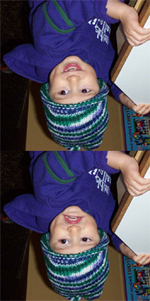|
|
 |
One of These Things Is Not Like the Other
 “Most people won't fully appreciate the differences between these two pictures until they're viewed upright.” That’s the “inversion effect,” which makes our brains work harder to process objects upside down, especially faces. “Most people won't fully appreciate the differences between these two pictures until they're viewed upright.” That’s the “inversion effect,” which makes our brains work harder to process objects upside down, especially faces.
“For most people, it's easy to recognize a range of faces, even
under various lighting conditions and from different views. But when
those faces are turned upside-down, we experience problems,” says
NSERC grantee Dr. Allison Sekuler.
Researchers originally thought that people recognize upright faces by organizing features across the whole face. Recognition of upside-down faces, however, relied much more on identifying local features.
Dr. Sekuler, a professor of psychology and Canada Research Chair in
Cognitive Neuroscience at McMaster University, set out to test that
idea. Her findings, published in Current Biology this month,
show an entirely new picture of what goes on when our brains look at
faces. She added “visual noise” (resembling snow on a de-tuned
television) to images of faces to get a clear view of how the brain
processes information about faces. By keeping track of how that “noise”
affected perception, the researchers were able to note that all observers
focused mostly on the area around the eyes and eyebrows, regardless
of whether the faces were upright or upside-down.
“The devil is in the details,” says Dr. Sekuler. “Although most of the relevant information for recognizing our faces was right around the eyes, people seem much more efficient at picking up that information in just the right way when the face is right side-up.”
Dr. Sekuler hopes that her research on how the brain normally processes this kind of information will lead to training programs for people who have impaired facial recognition skills, such as autistic individuals and some stroke victims.
Contact:
Dr. Allison Sekuler
Tel.: (905) 525-9140, ext. 27944
E-mail: sekuler@mcmaster.ca
|
